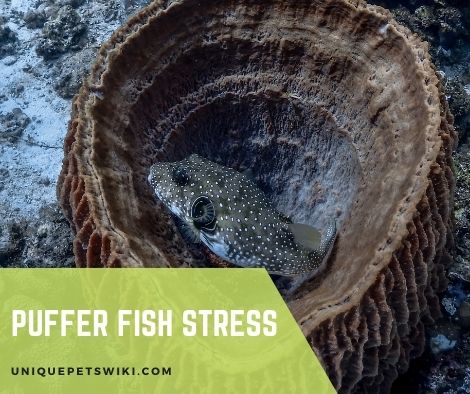Like humans, puffer fish can also get stressed. And just like in humans, stress can wreak havoc on your puffer fish’s health.
After all; stress releases cortisol and adrenaline in your fish, which, over time, can cause several health issues in your puffer fish.
In this guide, we will talk about how to diagnose stress in puffer fish, steps you can take to eliminate stress, and also what you need to do if you suspect your puffer fish is stressed.
Contents
Checklist for Pufferfish Health Problems
If your puffer fish suddenly appears ill or stressed out, consider the following parameters and checklists. These can help you take remedial actions so you can prevent your puffer fish’s stress from escalating.
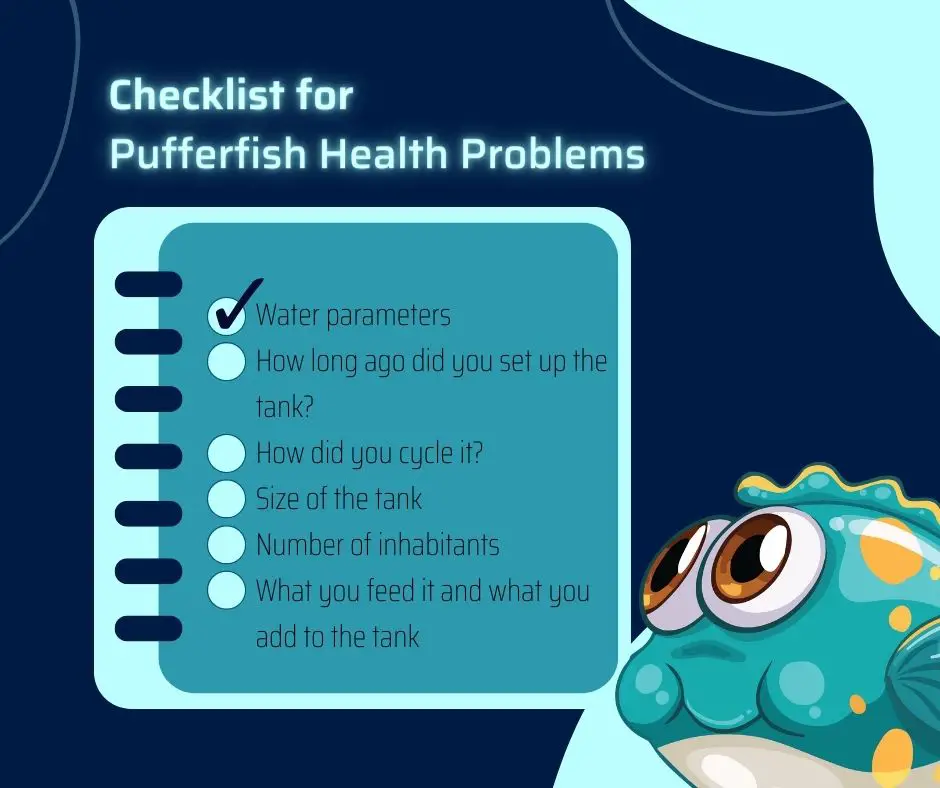
Water Parameters
Make sure that the water has the optimum levels of ammonia, nitrates, and nitrites. All fish should have 0 ammonia and 0 nitrites. Dwarf puffers can tolerate a nitrate level of around 10.
The pH level for your freshwater puffer fish should be between 7 and 7.6. On the other hand, pea puffers need a pH between 7.2 to 7.5. So, do your research and maintain the most optimum pH levels for your species of puffer.
Salinity levels should be between 1.005 to 1.008 as this level can help extend the lifespan of your puffer.
API 5-in-1 Test Strips Freshwater and Saltwater Aquarium Test Strips
- Contains one (1) API 5-IN-1 TEST STRIPS Freshwater and Saltwater Aquarium Test Strips 25-Count Box
- Monitors levels of pH, nitrite, nitrate carbonate and general water hardness in freshwater and saltwater aquariums
- Dip test strips into aquarium water and check colors for fast and accurate results
- Helps prevent invisible water problems that can be harmful to fish and cause fish loss
- Use for weekly monitoring and when water or fish problems appear
Last update on 2022-12-30 / Affiliate links / Images from Amazon Product Advertising API
How Long Ago Did You Set Up The Tank? How Did You Cycle It?
It is important to understand that it could take between 4 and 6 weeks to cycle a tank. If you have just established the tank, it is important that you wait before adding the fish in.
Only after you are sure that the ammonia and nitrite are 0 and nitrates are below 10 ppm, can you say that the tank is cycled and the nitrogen cycle is established.
Size of the tank
When you’re picking a tank for your puffer, it should never be smaller than 10 gallons for a single puffer. A small tank will get dirty quickly and dirty water is a major cause of stress in fish.
A small tank can also frustrate or depress your puffer fish. If your tank is smaller than 10 gallons, please buy a larger one right away.
Number of Inhabitants
Just as a small tank can stress your puffer, a crowded tank or one with the wrong inhabitants can also be detrimental to your puffer’s health. The choice of tank mates depends on your puffer fish’s species.
Dwarf, redeye and golden puffer fish do well with fast-moving fish like danios. Other species such as Mekong, Mbu, and Nile are better off alone.
In any case, when it comes to the total number of fish, follow the thumb rule of no more than 1-inch of fish per gallon of water.
Also, keep an eye on fish behavior. Perhaps there is an aggressive tank mate or a bully that may be stressing your puffer fish.
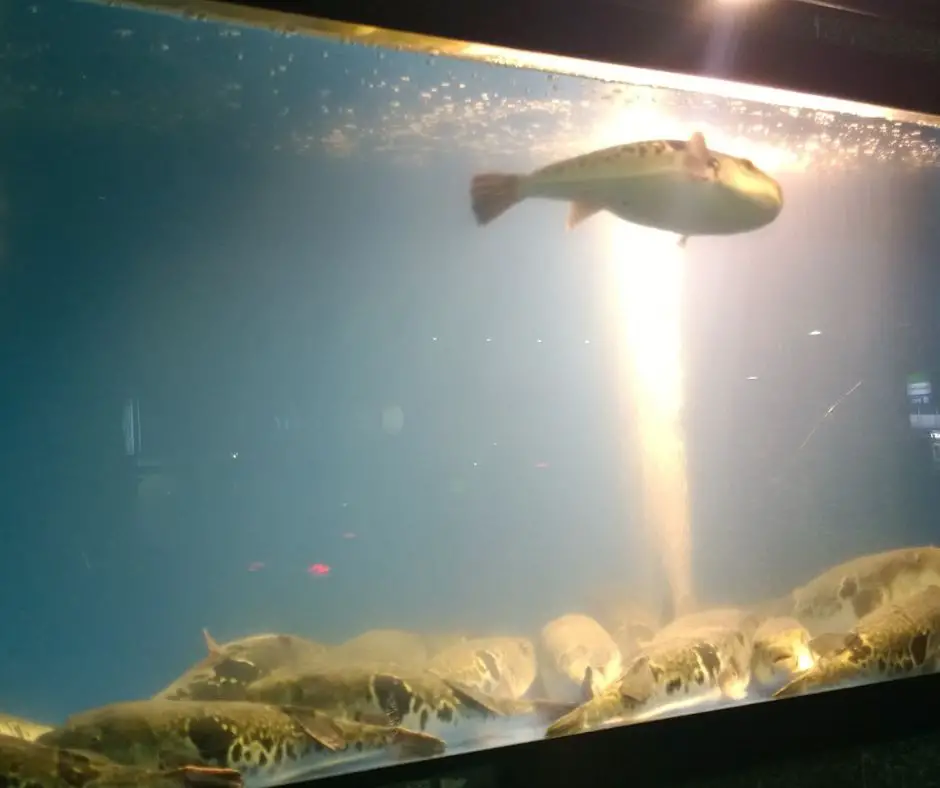
What You Feed It and What You Add To The Tank
If your puffer fish suddenly appears ill or stressed, consider what you’ve added to the tank or the type of food you fed it.
- Have you made food changes?
- Did you add a new water conditioner recently to the tank?
- When was the last water change? How much water did you change?
If you have made changes of any sort in the past week or so, it could have contributed to your puffer fish’s stress unknowingly.
API STRESS COAT Aquarium Water Conditioner 16-Ounce Bottle
- Contains one (1) API STRESS COAT Aquarium Water Conditioner 16-Ounce Bottle
- Makes tap water safe and protects fish with dual-action formula
- Removes chemicals from tap water that are harmful to fish
- Replaces fish’s protective coat damaged by handling, shipping or fish fighting with healing power of Aloe Vera extract
- Use when adding or changing water, when adding new fish and when fish are sick or injured
Last update on 2022-12-29 / Affiliate links / Images from Amazon Product Advertising API
Stress Signs in Puffer Fish
The signs and symptoms of stress in puffer fish are vast. Some of them may be natural behaviors too. So, it can be difficult to tell when things are off.
That is why it is important to know your puffer fish well and understand how it acts and behaves. That way you can tell when things are not normal.
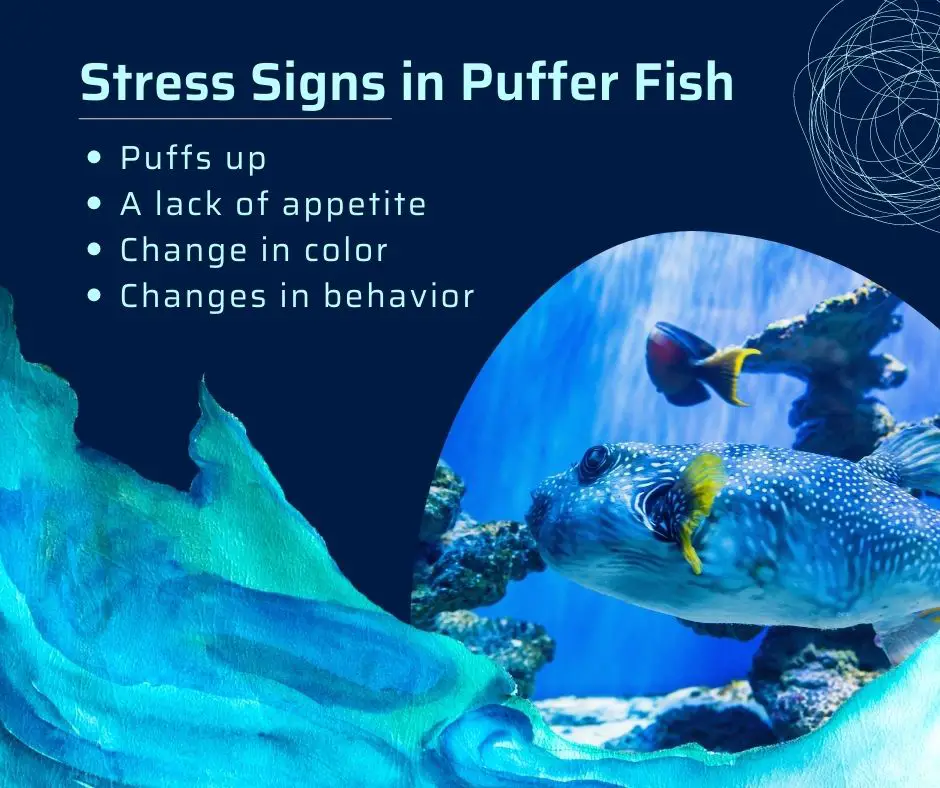
Here are the common signs of stress in puffer fish:
Puffs up – One of the most common signs of stress in puffers is puffing up. A stressed puffer will swallow a lot of water and swell up to almost thrice its normal size.
A lack of appetite – Another important sign of stress in puffers is that they stop eating. These pudgy fish love their food and eat with gusto when they are normal.
Naturally, a lack of appetite alone does not indicate ill-health or stress. It could also mean other things such as depression or sickness or unpalatable food.
Change in color – Puffer fish are of different colors depending on their species. Some of the common colors are grey, yellow, brown, blue, and white.
A stressed puffer fish might appear darker. Its belly might be greyish when normally it is white.
Changes in behavior – Another common sign of stress in puffers is behavioral changes. Your fish might hide or appear to bend or hunch over. Again, every once in a while, all fish hide.
But if your pet is constantly hiding and not swimming at all, then something is not right. Your pet may even breathe more heavily than usual.
Swimming around skittishly is normal if it is once in a while, but if your pet appears to constantly flit or dart around the tank, it may be stressed.
What Causes Stress in Pufferfish?
Stress in puffer fish prevents them from maintaining a normal physiological state. Here are the most common causes of stress in puffers:
- Small Tank Size
- Poor Water Quality
- Wrong tankmates
- Improper Care
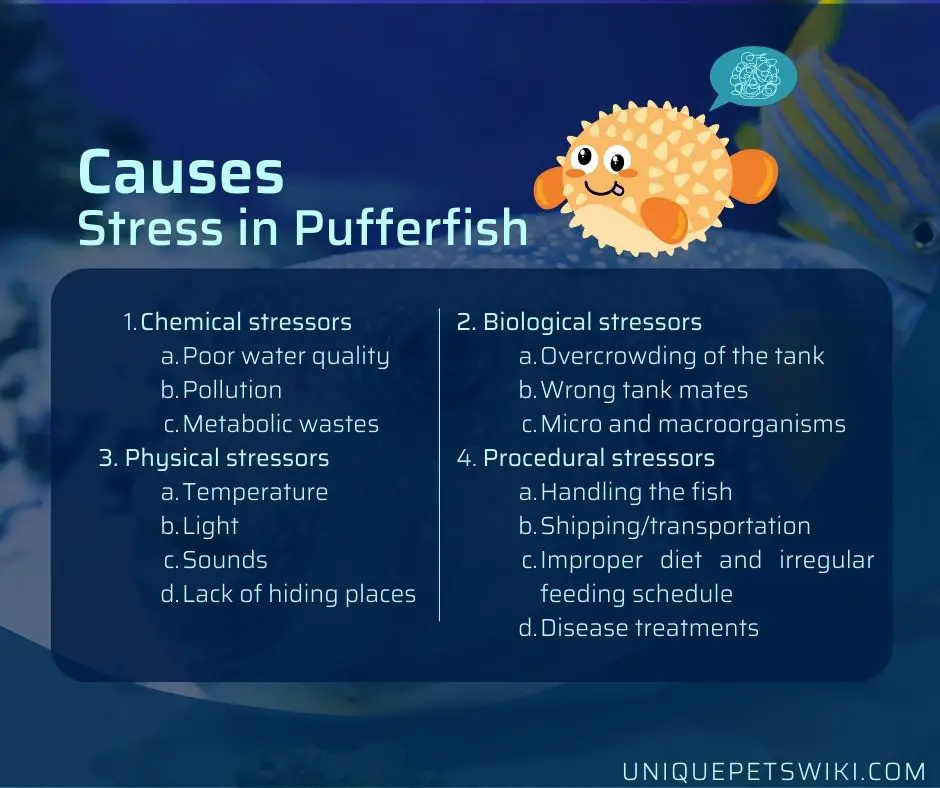
Chemical stressors
Poor water quality – improper pH and lower levels of dissolved oxygen can impact the water quality.
Pollution – accidentally spraying the tank with household cleaners/pesticides, use of ordinary tap water, or unconditioned water.
Metabolic wastes – high levels of ammonia, nitrite, and nitrate upset the tank’s nitrogen cycle.
Biological stressors
Overcrowding of the tank – a higher fish population in the tank means a lack of resources or in-fighting for resources.
Wrong tank mates – Puffers are selective in who they get along with. Some species of fish could end up bullying your puffer. Many fish are territorial and may not allow your puffer in its territory. Lateral swimming requirements can get impacted due to wrong fish companions.
Micro and macroorganisms – Microorganisms are disease-causing pathogens like bacteria or fungi. Macroorganisms could be internal or external parasites.
Physical stressors
Temperature – puffer fish need different water temperatures depending on their species. Most freshwater puffers need temperatures between 74° and 78° F. Anything beyond this range can upset your fish.
Light – Most sea-water pufferfish species live in the sunlight zone up to 650 m. However, most puffers need less or low light to stay happy.
Sounds – all fish are sensitive to vibrations, so loud music and ambient sounds could trigger stress.
Lack of hiding places – Fish need these to get a reprieve from the stress
Procedural stressors
Handling the fish – Puffers should not be touched and you should not keep them out of water. They could end up swallowing air and puffing up.
Shipping/transportation – Moving or transferring the puffer from one place to another can also induce stress.
Improper diet and irregular feeding schedule – lack of proteins and amino acids, old fish food, stale or spoilt foods, and untimely feeding can result in diseases and stress.
Disease treatments – this includes treating the fish or its mates for a disease outbreak such as ich in the tank. Certain medicines or treatments can also cause stress.
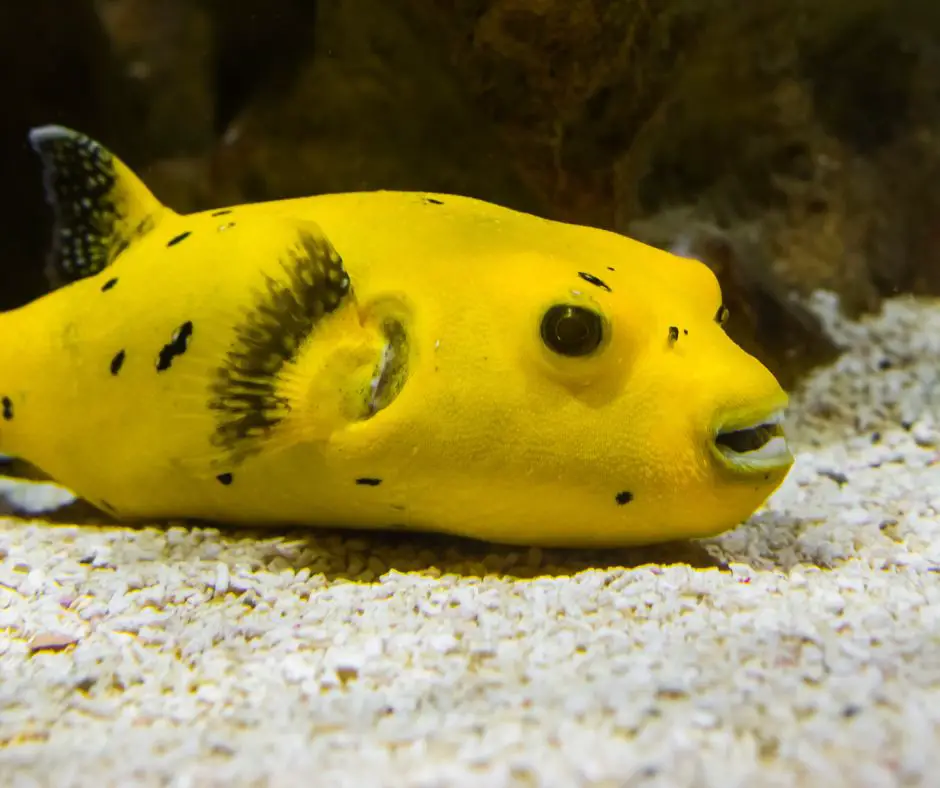
What Should You Do If Your PufferFish Is Stressed?
When a puffer fish is stressed, it tends to wreak havoc on its health. Stress can impact the fish’s immune system and increase its risk of disease. Long-term stress can even lead to your puffer’s death.
If your pufferfish are stressed, the best thing you can do is to try and remove the source of stress. This may mean moving the fish to a new tank, changing the water conditions, or adding more hiding places.
Once the stressor has been removed, you can help your fish recover by offering it a high-quality diet and plenty of clean, fresh water.
If your fish is still showing signs of stress after a few days, you should consult a veterinarian
How to Prevent Puffer Fish Stress
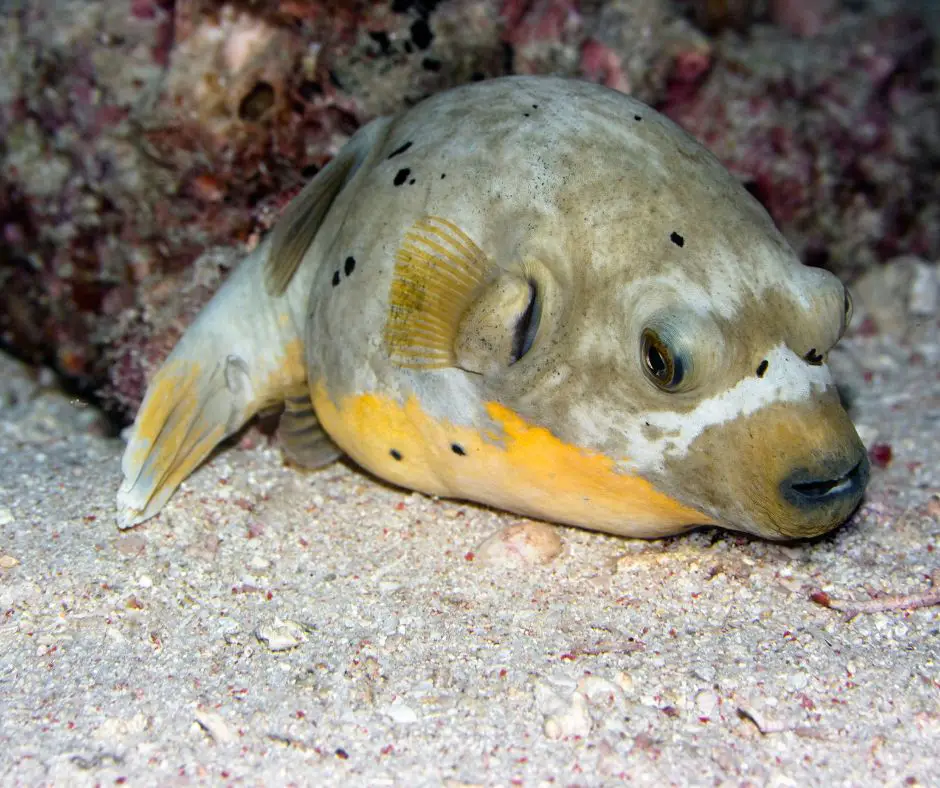
There are several ways to prevent stress in puffer fish. Providing it with an optimum environment is the best way to keep your puffer healthy and happy.
First, make sure that their environment is as close to their natural habitat as possible.
Stock the tank with the right aquarium decorations. Provide ample hiding places for the fish to get relief from the stress. At the same time, avoid over-crowding the tank.
Make regular water changes to keep ammonia, nitrite, and nitrate levels low. If needed, use a water conditioner which is known to relieve almost 40% of stress in fish.
Check water temperature to prevent fluctuations. Most puffers need temperatures between 72 and 82 F. In winters, you may need a water heater to maintain this temperature.
Provide a filter – this is to ensure proper oxygenation of the water. Low levels of oxygen can be dangerous and stressful to puffers. The filter will also remove debris and harmful bacteria.
Before adding new fish mates to the tank, make sure they are compatible with your puffer fish. If you notice bullying in the tank, separate the aggressive fish.
Use a larger tank if you have too many fish. Follow the thumb rule of a 1-inch length of fish per gallon of water.
Feed it a healthy diet. Make sure the food is fresh. Always feed at regular intervals. Discard expired or stale food. Store remaining food in a cool dry place in an airtight container.
MarineLand Penguin 350 Power Filter 50 – 75 Gallon Aquarium, 350 GPH
- WITH ROTATING BIO-WHEEL: Patented Bio-Wheel technology provides excellent wet/dry biological filtration.
- MULTI-STAGE FILTRATION: Delivers mechanical, chemical and biological aquarium filtration to maintain a clean aquatic environment.
- COMPATIBILITY: Use with Marineland Rite-Size Filter Cartridges (see individual filter for sizing recommendations).
- FIVE SIZES: Available in 75 GPH, 100 GPH, 150 GPH, 200 GPH and 350 GPH sizes.
- Age range description: All Life Stages
Last update on 2022-12-29 / Affiliate links / Images from Amazon Product Advertising API
Will My Fish Recover From Stress?
Stress in puffer fish can be of two types: short-term or long-term. Depending on the type, your puffer may recover from it within a few hours or not at all.
Short term stress
This type of stress tells your puffer about imminent danger and to run away from it. It causes the puffer’s body to release cortisol, adrenalin, and other hormones.
Usually, once the panic passes, your puffer might regain its natural balance. However, this can take a few hours or even days depending on the cause and effect of stress.
Long-term stress
A poor or unsuitable environment is usually one of the long-term stressors, especially if the environment continues to deteriorate.
Of course, your fish’s body will try to adapt to the situation, but during this adaptation period, it may become very weak and susceptible to diseases. Such stress can last for several weeks and could result in death.
Similarly, a bullying fish or aggressor could exhaust the puffer fish fatally.
Wrapping Up – Puffer Fish Stress
Stress is bad for all living beings. Puffer fish puff up when stressed and could inflate to thrice their normal size. This can be very harmful to the fish’s well-being.
A number of factors can cause puffer fish stress – poor water quality, wrong tank mates, improper handling, etc.
We hope this guide helps you determine the root cause of your puffer fish stress and ways to eliminate it.
